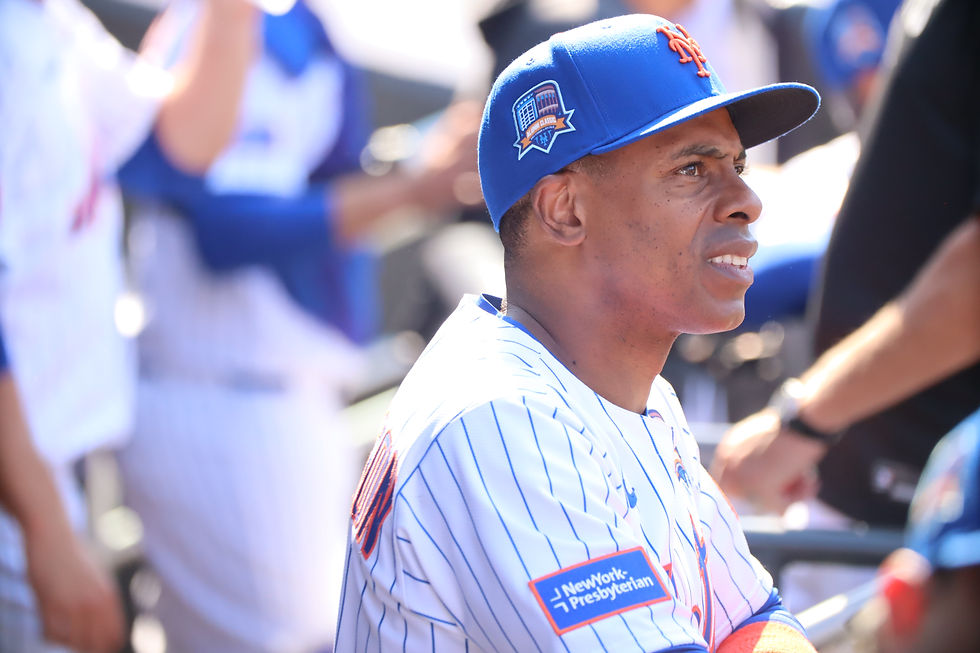Curtis, Carlos, and a Classic Afternoon in Flushing
- Mark Rosenman

- Sep 14
- 4 min read

One of the crueler tricks of time is how quickly baseball players turn into alumni. One minute, they’re legging out doubles and tracking fly balls in cavernous Shea Stadium gaps; the next, they’re pulling on throwback jerseys, smiling at fans who remember them best from a highlight reel or from what their parents told them.
Saturday at Citi Field, some 40 former Mets took the field for the Alumni Classic. Seeing them back in orange and blue brought the usual wave of nostalgia. And for those of us who grew up on this game , who measured summers by Shea’s scoreboard and winters by Hot Stove rumors , it wasn’t just an exhibition. It was time travel.
Before the festivities, I had the chance to chat with two men who, in very different ways, represent the heart of Mets baseball: Carlos Beltrán and Curtis Granderson.
Beltrán always struck me as the professor type , the guy who, even when he was stealing bases and hitting moonshots, looked like he was diagramming the pitcher’s sequencing in his head. In our conversation, he leaned into that teacher role, talking about mentoring today’s Mets players who arrive in the majors before they can legally rent a car.
“The most important thing,” Beltrán told me, “is to support them in the process. Baseball is a game of failure.”
He’s right, of course. This is the only profession where failing seven times out of ten makes you rich and famous. If I failed seven times out of ten in my job, I’d be asking if you’d like fries with that. But Beltrán’s point was that young players need to be reminded to keep working on the little things that got them there in the first place.
I asked him about facing today’s pitching, where everyone seems to throw 98 and the radar gun is more important than the box score. He didn’t blink: “You always look for the fastball.” For Beltrán, it was about staying up the middle, keeping the approach simple, not letting velocity rattle the focus. Tony Gwynn would’ve approved.
He lit up when I mentioned Luis Arraez, calling him “super elite.” Here’s a guy who hits line drives, gets on base, and makes things happen — and yet in today’s game, that’s somehow less sexy than a slugger who strikes out 180 times but hits 30 bombs. Beltrán was having none of that. “Arraez should be compensated for what he does,” he said firmly. I almost wanted to forward the quote directly to the Mets front office with “cc: Steve Cohen.”
Curtis Granderson, on the other hand, remains the eternal optimist, still flashing that grin that made him a fan favorite. Watching him shag balls in batting practice, I got a flashback to the 2015 playoffs, when Granderson seemed to catch everything hit within a zip code of right field.

“What does it feel like to put the uniform back on?” I asked.
He smiled. “It’s really cool and exciting… the Mets organization, the Cohen family, the fans — just being back out here means a lot.”
Granderson’s joy was always contagious. And when I asked him about the fun sometimes being drained from today’s hyper-analytic game, he gave me one of the better analogies I’ve ever heard.
“It’s like Lifetime gym,” he said. “You walk in and there’s all this equipment — barbells, treadmills, medicine balls. Everything in there could be good, but you have to find what’s good for you.”
As someone who hasn't made it passed the pickleball courts at my Lifetime, I had to laugh — but the point hit home. In baseball, as in fitness, focus matters more than variety. Narrow in, stay present, and the joy remains.
We also talked about how he’d approach hitting today’s pitchers. Granderson admitted he’d be a lot more aggressive on the first pitch, rather than working counts to get to bullpens. “Now, if I were doing it, I’m up there first-pitch hacking,” he grinned. Somewhere Keith Hernandez is nodding in approval.
When I asked him who he was most looking forward to facing in the Alumni game, his answer was classic Granderson: Pedro Martínez. He never faced him in his career, so technically, he remains 1.000 lifetime. That’s the kind of optimism only Curtis could pull off — and the kind of math Mets fans like me can live with.
As the game itself unfolded — a tidy 2–2 tie, which somehow feels on-brand for this franchise — I kept thinking about how guys like Beltrán and Granderson embody what we love about the Mets. Beltrán, the thinker, always dissecting, always learning, always reminding us that the game is about discipline and approach. Granderson, the joy-bringer, playing like every inning was his first Little League game.

And maybe that’s why the Alumni Classic matters so much. It’s not just about remembering the good times. It’s about reconnecting with the essence of baseball — a sport built on failure and joy, patience and aggression, heartbreak and euphoria, often all in the same inning.
For one afternoon in Flushing, watching Carlos and Curtis, it felt like baseball at its best. And it reminded me why, at my age, I still write about this silly, beautiful game with the wide-eyed love of a kid walking into Shea for the first time.




Comments